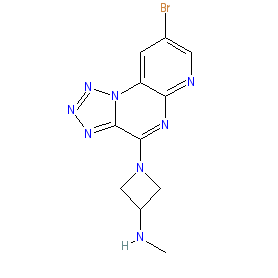GtoPdb is requesting financial support from commercial users. Please see our sustainability page for more information.
|
Compound class:
Synthetic organic
Comment: Compound 48 is an orally active, selective histamine H4 receptor antagonist that was developed as a potential therapy for the pruritis and inflammation associated with atopic dermatitis [4].
Ligand Activity Visualisation ChartsThese are box plot that provide a unique visualisation, summarising all the activity data for a ligand taken from ChEMBL and GtoPdb across multiple targets and species. Click on a plot to see the median, interquartile range, low and high data points. A value of zero indicates that no data are available. A separate chart is created for each target, and where possible the algorithm tries to merge ChEMBL and GtoPdb targets by matching them on name and UniProt accession, for each available species. However, please note that inconsistency in naming of targets may lead to data for the same target being reported across multiple charts. ✖ |
|
|||||||||||||||||||||||||||||||||||
| References |
|
1. Cowden JM, Zhang M, Dunford PJ, Thurmond RL. (2010)
The histamine H4 receptor mediates inflammation and pruritus in Th2-dependent dermal inflammation. J Invest Dermatol, 130 (4): 1023-33. [PMID:19907432] |
|
2. de Esch IJ, Thurmond RL, Jongejan A, Leurs R. (2005)
The histamine H4 receptor as a new therapeutic target for inflammation. Trends Pharmacol Sci, 26 (9): 462-9. [PMID:16054239] |
|
3. Fung-Leung WP, Thurmond RL, Ling P, Karlsson L. (2004)
Histamine H4 receptor antagonists: the new antihistamines?. Curr Opin Investig Drugs, 5 (11): 1174-83. [PMID:15573868] |
|
4. Ko K, Kim HJ, Ho PS, Lee SO, Lee JE, Min CR, Kim YC, Yoon JH, Park EJ, Kwon YJ et al.. (2018)
Discovery of a Novel Highly Selective Histamine H4 Receptor Antagonist for the Treatment of Atopic Dermatitis. J Med Chem, 61 (7): 2949-2961. [PMID:29579390] |
|
5. Ohsawa Y, Hirasawa N. (2012)
The antagonism of histamine H1 and H4 receptors ameliorates chronic allergic dermatitis via anti-pruritic and anti-inflammatory effects in NC/Nga mice. Allergy, 67 (8): 1014-22. [PMID:22686688] |
|
6. Suwa E, Yamaura K, Oda M, Namiki T, Ueno K. (2011)
Histamine H(4) receptor antagonist reduces dermal inflammation and pruritus in a hapten-induced experimental model. Eur J Pharmacol, 667 (1-3): 383-8. [PMID:21664903] |








